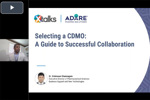A Guide To Pharmaceutical & Biotech Development & Manufacturing Outsourcing
Pharmaceutical outsourcing is a fundamental cornerstone of the biopharmaceutical industry. However, engaging external partners is a complex process that requires precise calibration to create a mutually beneficial relationship and avoid common roadblocks.
This guide is the first in a series designed to help CMC (chemistry, manufacturing, and controls), outsourcing, operations, R&D professionals, and other biopharmaceutical executives optimize CDMO partnerships. This installment sets the stage for CDMO engagement and discusses:
- What Is Outsourcing In Pharma & Biotech?
- When & Why To Outsource
- CDMOs Vs. CMOs Vs. CROs: Understanding The Landscape
- Key Functions Outsourced To CDMOs
- The CDMO Relationship Lifecycle
- The Future Of Outsourcing In Pharma/Biotech
- Common Outsourcing Models & Business Strategies
- Risks, Challenges, & Mitigation Strategies
- Resources & Next Steps
- Frequently Asked Questions (FAQs)
What Is Outsourcing In Pharma & Biotech?
Biopharma outsourcing leverages contract development and manufacturing organizations (CDMOs) to manage internal resource constraints and accelerate drug development timelines, freeing sponsors to focus on innovation and core competencies. Commonly, CDMOs are contracted to perform specialized services including:
- Drug substance and drug product development
- Formulation development and optimization
- Analytical method development and testing
- Process scale-up and technology transfer
- Clinical and commercial manufacturing
In today’s highly competitive biopharmaceutical market, successful outsourcing is crucial to developing new therapeutics while safeguarding scientific rigor and regulatory approval.
When & Why To Outsource
Working with a CDMO can be a tactical or strategic decision that enables sponsors to remain competitive, responsive, and innovative in a complex, highly regulated global industry. Typically, sponsors turn to external partners for strategic or operational reasons. Additionally, over the past decade, biotechs have focused on staying lean, virtual, and rely entirely on outsourcing.
Virtual Biopharma Models
Virtual biopharma companies with no internal laboratories or manufacturing assets represent a growing industry trend. These companies depend on outsourcing partners for every aspect of drug development; thus, finding the right outsourcing partners and proactively managing CDMO relationships is crucial to their success.
Strategic Motivations
CDMOs provide specialized expertise for everything from small molecules, to particularly for highly technical or emerging fields, including biologics, mRNA platforms, and cell and gene therapies. For instance, a small biotech creating its first biologic may require end-to-end capability from its CDMO partners.
Speed-to-market is paramount, and a CDMO with existing infrastructure can develop or manufacture a new drug much faster than a company can build in-house capabilities. Frequently, CDMOs integrate development and manufacturing for increased agility, accelerating timelines for highly competitive therapeutic areas.
Additionally, sponsors must strategically prioritize their CAPEX. Building GMP-compliant facilities from the ground up plus personnel expenses equals a high CAPEX commitment, which is infeasible for early-stage or resource-constrained companies. However, even large pharmaceutical companies wish to preserve capital for pipeline expansion, licensing, or other strategic priorities.
CDMOs also provide improved supply chain flexibility. Partners with global footprints and multi-site capabilities mitigate supply chain risks, manage regional market requirements, and offer greater scalability.
Operational Drivers
Many pharmaceutical companies turn to CDMOs to fill gaps in internal operational capacity. Challenges like rapid growth, new product launches, or demand surges can strain existing operations. For example, a mid-sized company with a fast-paced pipeline may seek an external partner to help develop a new product line.
Regulatory compliance and regionalization further complicate drug development. Meeting the expectations of the FDA, EMA, or other local authorities requires region-specific expertise and facility alignment. Companies looking to enter the global market benefit from partnering with CDMOs that are well-versed in local GMP requirements and supply logistics.
CDMOs Vs. CMOs Vs. CROs: Understanding The Landscape
This guide focuses on CDMO partnerships, but the pharmaceutical industry relies on several types of external partners:
- CDMOs offer development and manufacturing services for drug substances and products, including formulation, analytical testing, scale-up, and commercial production.
- CMOs (contract manufacturing organizations) provide manufacturing activities without upstream development support. Companies may prefer a CMO if they have completed early development in-house or with another partner.
- CROs (clinical research organizations) specialize in clinical trial design, execution, and data analysis.
- Hybrid models combine development and manufacturing with additional support services like regulatory consulting.
- Full-service providers manage the entire drug development lifecycle, from preclinical research to commercial supply.
Key Functions Outsourced To CDMOs
Sponsors can work with CDMOs at any stage in the drug development lifecycle, and the partnership’s scope varies according to the sponsor’s internal capabilities and those at the CDMO, program complexity, and product type.
Early-Stage Development
Early-stage development outsourcing often includes formulation, in which the drug delivery methods, excipients, and dosage forms are selected and optimized. Small biotechs may need CDMOs to provide complete preclinical manufacturing services, such as small-batch production for toxicology studies.
CDMOs can also establish validated, phase-appropriate analytical methods to characterize the drug substance or product’s identity, potency, purity, and stability. These services support ongoing development and produce foundational data for regulatory submissions.
Clinical Supply Manufacturing
When sponsors are ready to initiate clinical trials, they commonly turn to CDMOs for clinical trial material (CTM) supply, manufactured under GMP conditions, to ensure that the format, dosage, and packaging are suitable for human use.
Scale-up and tech transfer are crucial at this stage. Processes suitable for lab or pilot scale must be adapted to accommodate larger production volumes without compromising product quality or consistency. A smooth tech transfer from sponsor to CDMO includes detailed documentation, cross-functional coordination, and risk mitigation planning.
Commercial Manufacturing
Once a new drug is approved, sponsors often partner with CDMOs for robust, efficient, and fully compliant commercial manufacturing. Sponsors may lack the infrastructure to produce the API or drug product commercially or wish to diversify their supply network.
CDMOs also offer downstream services like packaging and serialization, which are necessary for regulatory compliance and product traceability across regions.
Specialized Services
CDMOs can provide highly specialized services for sponsors with a specific capability gap to fill. For instance, highly potent active pharmaceutical ingredients (HPAPIs) require specialized handling, including containment facilities, engineered controls, and trained personnel to protect product integrity and worker safety.
Cell and gene therapies also demand specialized manufacturing platforms, viral vector production, and complex quality control methods. To maintain sterility, these therapies require containment and controlled environments like aseptic suites, isolators, and cleanrooms. Sponsors developing highly technical, innovative therapeutics can partner with CDMOs specializing in these capabilities.
The CDMO Relationship Lifecycle
This preliminary guide begins a series that walks biopharmaceutical executives through the entire CDMO engagement process. Additional guides in the series include:
Preparing For CDMO Outsourcing: Key Steps For Successful Biopharma Collaboration
Internal alignment is crucial to creating successful partnerships. This page helps sponsors prepare their team, data, processes, and product knowledge for a smooth transition to external development and manufacturing.
How To Select The Right CDMO
Choosing the right CDMO is a complex, strategic decision. This guide helps sponsors objectively assess a potential partner’s capabilities, culture, compliance history, and technical fit and provides best practices for due diligence and site evaluation.
How To Onboard A CDMO & Execute A Seamless Tech Transfer
The onboarding process establishes the sponsor-CDMO relationship. This guide covers project kickoff, technology transfer management, documentation handoffs, and quality agreements.
How To Manage CDMOs: Best Practices For Development & Manufacturing
Finally, a successful partnership requires intentional, ongoing maintenance that relies on clear governance structures and open communication. This page explores KPIs, structured communication channels, audits, and escalation protocols.
The Future Of Outsourcing In Pharma/Biotech
The global CDMO landscape is rapidly growing and evolving to keep pace with market forces, innovation, and regulatory changes.
Consolidation And M&A
The CDMO sector has consolidated significantly in recent years, with larger companies acquiring specialized providers to expand their capabilities and geographic reach.
For large sponsors, this trend grants access to integrated service networks and advanced technologies but adds complexities when a CDMO's personnel, systems, or priorities shift. However, consolidation can negatively impact emerging biotechs when CDMOs grow too big and prioritize their largest customers. Small biotechs can lose leverage and get shut out of capacity. When selecting a CDMO partner, sponsors of all sizes should consider the company's stability, integration success, and how post-merger alignment might affect project execution.
Geographic Diversification
In today’s international market, global supply chain resilience is vital. CDMOs are expanding their operations across regions to reduce risks and meet local market requirements. Sponsors can leverage these global operations to produce therapies closer to their target markets and local regulatory authorities while enabling redundancy and continuity planning.
Demand For Modality-Specific Expertise
Creating complex, novel modalities like mRNA, antibody-drug conjugates (ADCs), cell therapies, and oligonucleotides requires dedicated handling, containment, and process development capabilities. Sponsors developing advanced therapies need CDMO partners with demonstrated expertise, appropriate infrastructure, and a robust, relevant regulatory track record.
Regulatory Expectations For Outsourced GMP Compliance
Many regulatory agencies stress that sponsors cannot outsource GMP compliance. Sponsors are accountable for their product’s quality, safety, and efficacy, regardless of manufacturer. Clear oversight models, quality agreements, and audit trails must be maintained.
Likewise, CDMOs must continuously prepare for inspections and align with global GMP standards. Sponsors are increasingly using formalized governance structures and quality metrics to meet regulations.
Common Outsourcing Models & Business Strategies
Outsourcing is not a one-size-fits-all solution. Companies choose between various business models and objectives depending on their development stage, internal capabilities, and long-term goals.
Fee-For-Service Vs. Time & Materials Vs. Risk-sharing
Sponsors have options from fee-for-service to risk-sharing models for their financial agreement with the CDMO.
The most commonly used model is fee-for-service. In this arrangement, sponsors pay for specific deliverables like manufacturing runs, stability studies, or analytical method development. Sponsors often prefer this model because it offers predictability and transactional clarity.
For time and materials (TM) arrangements, sponsors pay the CDMO according to the hours worked and materials used. This method is commonly used in early development or undefined-scope projects because it offers flexibility. However, it can be difficult to budget precisely.
Sponsors relying on TM arrangements maintain oversight through detailed billing and time tracking. Once the project scope is clearly defined, TM arrangements can transform into fixed-price or milestone-based models. Risk-sharing models are the least common method but are gaining popularity, especially for innovative or high-risk programs. In this model, sponsors share clinical or commercial upsides with the CDMO in exchange for reduced upfront costs or co-investment in development.
Dedicated Capacity Vs. Flexible Resource Models
Next, sponsors must consider capacity strategy. Dedicated capacity gives sponsors exclusive access to a CDMO’s specific lines, suites, or equipment, which grants control and scheduling priority. However, this method often comes with long-term commitments and increased costs.
A flexible resource model uses a shared infrastructure and just-in-time scheduling to maximize agility and cost-effectiveness. The ideal approach depends on the project’s predictability, volume, and strategic importance.
Strategic Partnerships Vs. Transactional Engagements
The sponsor-CDMO relationship may entail a long-term strategic partnership or a temporary, transactional engagement. In a strategic partnership, the sponsor and CDMO share goals and align governance, often through joint steering committees, multi-program frameworks, and frequent touchpoints. On the other hand, a transactional engagement is appropriate for a single project with limited scope, focusing on execution over integration.
Risks, Challenges, & Mitigation Strategies
Outsourcing provides invaluable support to pharma companies of all sizes. However, working with a CDMO introduces operational and strategic risks.
Tech Transfer Delays
Tech transfer is complex, and delays are costly. Incomplete documentation, unclear roles, or poor planning can be avoided through early engagement, collaborative planning, and detailed transfer protocols.
IP Protection Concerns
Trusting an external partner with proprietary methods, data, or formulations requires more than a leap of faith. Robust contractual safeguards, defined data access controls, and selecting partners with strong reputations for integrity mitigate IP risks.
Supply Chain Bottlenecks
Supply chain risks, including raw material shortages and logistical issues, are all too common. Sponsors should collaborate with CDMOs to identify alternate suppliers, build a buffer inventory, and diversify sourcing strategies.
Quality Oversight
Sponsors and CDMOs share responsibility for product quality and regulatory compliance. Routine audits, performance metrics, and transparent quality agreements support transparency and help sponsors quickly identify and react to issues.
Capacity Shortfalls
CDMOs may experience demand surges or limited production slots, creating bottlenecks. Advanced forecasting, flexible agreements, and strong cross-functional planning help ensure capacity aligns with the program’s needs.
Resources & Next Steps
For more information about engaging a CDMO, you can visit the other pages in this series:
- Preparing for CDMO Outsourcing
- How To Select The Right CDMO
- CDMO Onboarding And Tech Transfer
- How To Manage CDMOs.
Additionally, the Outsourced Pharma Capacity Update can help you find a CDMO that meets your needs and timeline, while our annual CDMO Leadership Awards celebrate the industry’s MVPs.
Frequently Asked Questions (FAQs)
Below is a list of frequently asked questions about biopharma outsourcing.
1. What is biopharma outsourcing?
Biopharma outsourcing involves contracting external organizations like CDMOs for drug development and manufacturing functions. These include formulation, analytical testing, scale-up, and commercial production of drug substances and drug products.
2. Why do biopharma companies outsource development and manufacturing?
Companies outsource for strategic and operational reasons, such as accessing specialized expertise, accelerating speed to market, avoiding capital expenditures, overcoming internal capacity limitations, and ensuring regulatory compliance across regions.
3. What’s the difference between a CDMO, CMO, and CRO?
A CDMO provides both development and manufacturing services. A CMO focuses solely on manufacturing. A CRO offers clinical research services unrelated to manufacturing.
4. What types of work are typically outsourced to CDMOs?
CDMOs support early-stage development (e.g., formulation, method development), clinical supply manufacturing (e.g., CTM production, tech transfer), commercial manufacturing (e.g., fill-finish, packaging), and specialized services (e.g., HPAPI handling, cell and gene therapy).
5. How do I prepare my organization to work with a CDMO?
Internal alignment is critical. Sponsors should prepare detailed technical documentation, define project goals, establish cross-functional teams, and ensure readiness for knowledge transfer and regulatory engagement.
6. What factors should I consider when selecting a CDMO?
Key factors include the CDMO’s technical capabilities, regulatory track record, cultural fit, geographic footprint, and flexibility to scale. Strategic alignment and due diligence are also critical.
7. What is involved in onboarding a CDMO partner?
Onboarding includes project kickoff meetings, technology transfer planning, sharing of technical documentation, and negotiating quality agreements that define roles, responsibilities, and performance expectations.
8. How can I manage a CDMO relationship effectively?
Successful management involves setting clear KPIs, maintaining structured communication, conducting routine audits, and establishing escalation protocols to resolve issues efficiently.
9. What trends are shaping the CDMO market today?
Major trends include industry consolidation, global diversification of facilities, rising demand for modality-specific expertise (e.g., mRNA, ADCs), and heightened regulatory scrutiny around outsourced GMP compliance.
10. What are common outsourcing risks, and how can I mitigate them?
Risks include tech transfer delays, IP protection challenges, supply chain bottlenecks, quality lapses, and capacity limitations. These can be mitigated with detailed planning, strong contracts, supplier diversification, and proactive governance.
About The Author
Elizabeth Mann is a skilled writer with over a decade of experience in content creation, specializing in the life sciences industry. As a writer for Life Science Connect, she develops in-depth content that informs and engages professionals in the pharmaceutical, biotech, and medical device sectors. Her areas of focus include biologic drug production (including cell and gene therapies), clinical trial design and execution, and drug development and manufacturing outsourcing.
EDITORIAL PERSPECTIVES ON OUTSOURCING
-
The Mighty CDMOs Producing API
CDMO focused on active pharmaceutical ingredients (APIs) have long been vital components in the supply chain. Today, they are more than your enablers. CDMO have become strategic actors helping to reshape global outsourcing markets. A new report focuses on the new forces raising their importance.
-
Early-Phase Formulation Done Right: An Expert Analysis
Dileep Boinipally has extensive experience in formulation, manufacturing process development, and regulatory strategy. He’s adept at explaining all that, but Chief Editor Louis Garguilo got him to focus for readers on the ins-and-outs of the practice of early formulation development.
-
The Serious Business Of Working With CDMOs At Phase 2
You might call Anthony Grenier, Sr Director CMC at Reunion Neuroscience, a "phase 2 outsourcing specialist." In his discussion with Chief Editor Louis Garguilo, he describes his experiences, and presents some key factors and advice for biotechs at that middle stage of working with CDMOs.
-
How Do We Categorize CDMOs?
Are we on the same page? Do we need to be? That is, how do we differ on what might seem like the mundane defining of CDMOs as small, medium, or large? Some readers have been asking. How might this determination be relative and important to individual sponsors? Our Advisory Board members weigh in.
-
They Said What? Unexpected Insights Into CDMO Selection
An assortment of conversations with experienced biopharma executives have generated some surprising commentary about CDMO selection. Chief Editor Louis Garguilo puts those insights together in this editorial. They include selection preparation/responsibilities, and some interesting CDMO behaviors of late.
EXPERT INSIGHTS ON OUTSOURCING
-
Smarter CDMO Engagement With AI In Biologics And Cell & Gene Therapy
In biologics and cell and gene therapy (CGT), selecting and managing a CDMO has become a strategic imperative. Unfortunately, traditional approaches to external partners can fall short. But now AI is reshaping this landscape. Analysis from an Outsourced Pharma Board member.
-
Scaling Up Manufacturing? Here's Why You Need A CMC Specialist
CMC experts (whether in-house or outsourced) fill a vital role during the transition from small-scale production to larger operations for maintaining quality, consistency, and compliance.
-
A Road Map For Transitioning From A Research-Focused To Commercialization Mindset
As the timeline for commercialization closes in, it’s necessary to best position the organization for a successful launch. Where to start?
-
8 Actions To Redefine Sponsor–CDMO Relationships
When viewing a CDMO as merely a service provider, interactions are often limited to completing tasks. This mindset can stifle innovation and problem-solving.
-
To Enhance Biotech Investments, Involve CDMOs Early In CMC Decisions
In Part 1, we introduced the critical link between CMC and prospective investors and/or licensees. Here we conclude with suggestions for how CDMOs can lend expertise early in discovery/development to improve the probability of securing investment or license for their clients.
ON-DEMAND WEBINARS ON OUTSOURCING
-
Growing A Sustainability Culture Across An Expanding CDMO Network
Peter Skals, Head of Global Sustainability, shares how the company is integrating its climate and ESG strategy while simultaneously expanding its CDMO network and reducing its CO2 footprint.
-
Reducing Risks By Outsourcing OSD Manufacturing And Packaging
Watch to discover the key benefits of outsourcing your OSD production and explore real-world examples and best practices to help you streamline your processes and enhance your operational agility.
-
Contract Manufacturing: Must-Know Trends And Strategies For 2025
Regulated industries face rising demand, tech breakthroughs, and regulatory harmonization. Discover how contract manufacturers must leverage AI and cloud solutions to stay agile and compliant in the future.
-
Selecting A CDMO: A Guide To Successful Collaboration
Join Dr. Srinivasan Shanmugam in this webinar to learn key strategies for selecting the right CDMO, reducing costs, accelerating timelines, and ensuring product success.














